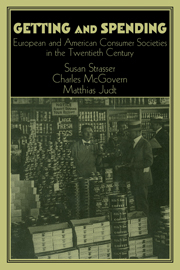Book contents
- Frontmatter
- Introduction
- Part One Politics, Markets, and the State
- Part Two Everyday Life
- 9 World War I and the Creation of Desire for Automobiles in Germany
- 10 Gender, Generation, and Consumption in the United States: Working-Class Families in the Interwar Period
- 11 Comparing Apples and Oranges: Housewives and the Politics of Consumption in Interwar Germany
- 12 “The Convenience Is Out of This World”: The Garbage Disposer and American Consumer Culture
- 13 Consumer Culture in the GDR, or How the Struggle for Antimodernity Was Lost on the Battleground of Consumer Culture
- 14 Changes in Consumption as Social Practice in West Germany During the 1950s
- 15 Reshaping Shopping Environments: The Competition Between the City of Boston and Its Suburbs
- 16 Toys, Socialization, and the Commodification of Play
- 17 The “Syndrome of the 1950s” in Switzerland: Cheap Energy, Mass Consumption, and the Environment
- 18 Reflecting on Ethnic Imagery in the Landscape of Commerce, 1945-1975
- Part Three History and Theory
- Index
11 - Comparing Apples and Oranges: Housewives and the Politics of Consumption in Interwar Germany
Published online by Cambridge University Press: 05 January 2013
- Frontmatter
- Introduction
- Part One Politics, Markets, and the State
- Part Two Everyday Life
- 9 World War I and the Creation of Desire for Automobiles in Germany
- 10 Gender, Generation, and Consumption in the United States: Working-Class Families in the Interwar Period
- 11 Comparing Apples and Oranges: Housewives and the Politics of Consumption in Interwar Germany
- 12 “The Convenience Is Out of This World”: The Garbage Disposer and American Consumer Culture
- 13 Consumer Culture in the GDR, or How the Struggle for Antimodernity Was Lost on the Battleground of Consumer Culture
- 14 Changes in Consumption as Social Practice in West Germany During the 1950s
- 15 Reshaping Shopping Environments: The Competition Between the City of Boston and Its Suburbs
- 16 Toys, Socialization, and the Commodification of Play
- 17 The “Syndrome of the 1950s” in Switzerland: Cheap Energy, Mass Consumption, and the Environment
- 18 Reflecting on Ethnic Imagery in the Landscape of Commerce, 1945-1975
- Part Three History and Theory
- Index
Summary
Even in autumn, the fruit of our homeland, the apple, is unreasonably neglected [by housewives] and in its place many sorts of oranges are consumed in astonishing quantities.
The German Housewife, 1927[Under the Four Year Plan] we attempted [to guide housewives] to return to the healthier foods of our ancestors, and above all to reduce the excessive demand for meat, which was common in all highly civilized societies . . . we especially advocated the use of whole grains . .. and whole grain bread (Vollkornbrot).
Else Vorwerck, 1948This chapter examines how the politics of consumption during the interwar period were framed and pursued by German housewives' organizations. It is part of a larger project that analyzes the ways in which the Hausfrau and housewifery were redefined under successive political regimes and links the competing images of the Hausfrau that bourgeois housewives' organizations advanced during this period to their politics of consumption. Within this framework, I will focus on three areas: the ambivalent values assigned to categories of products (especially foods) in these discussions, the trade-off between wasting labor and wasting resources in consumption and housework, and the balance of power or authority between the housewife-consumer and small retailers or artisans. There were strong continuities in all of these areas between 1914 and 1939, which still resonated in the post-1945 period.
- Type
- Chapter
- Information
- Getting and SpendingEuropean and American Consumer Societies in the Twentieth Century, pp. 241 - 262Publisher: Cambridge University PressPrint publication year: 1998
- 5
- Cited by



